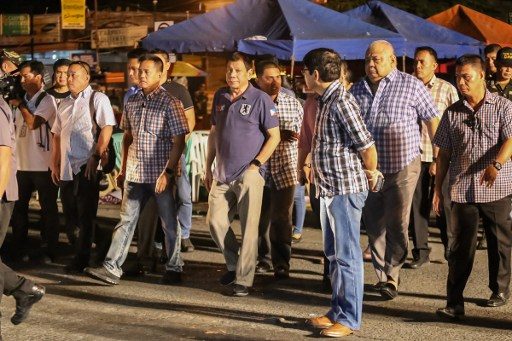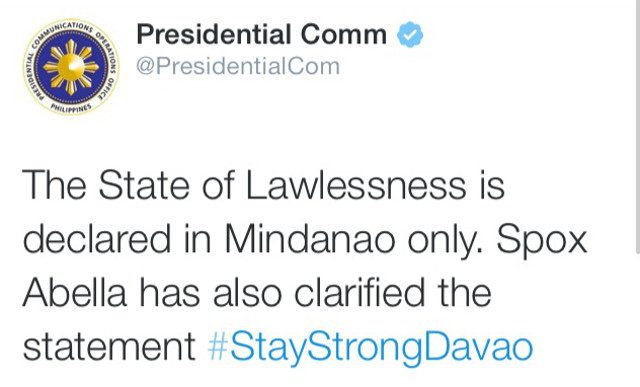SUMMARY
This is AI generated summarization, which may have errors. For context, always refer to the full article.

Hours after a Davao City explosion, President Rodrigo Duterte made an equally explosive announcement: he would declare a “state of lawlessness in the country.”
The phrase by itself is alien and unfamiliar to many Filipinos, but the ensuing back and forth on whether the declaration covered only Mindanao or the entire country only made things worse.
The government has a duty to inform citizens properly about important announcements – especially of such magnitude – more so, in times of great uncertainty and fear.
The hours it took to get a definitive and unified response from government officials suggest loose, or even missing, links in the administration’s communication chain in the wake of its first major crisis.
So what happened?
First, President Duterte mentioned his intention to declare a state of lawlessness at around 5 am during an interview with media. He did not specify what the declaration covered, but said it would be implemented “in the country.”
Things quieted down a bit. The sun rose; hours passed. Journalists who joined the President at the explosion site managed to get some sleep.
At around 9:30 am, media received a message claiming that Special Assistant to the President Christopher “Bong” Go issued a clarification: “Declaration of state of lawlessness in Mindanao only.”
A few minutes later, some journalists were able to talk to Go personally. Go supposedly said that this is what he heard Duterte say during the early morning interview, and perhaps during the emergency command conference the President presided over. Go said he would talk to the President first to confirm.
But after some minutes, Communications Assistant Secretary Queenie Rodulfo and Presidential Spokesman Ernesto Abella told media that, indeed, the state of lawlessness only covers Mindanao.
Two confirmations from two official sources, one of them the designated spokesman of the President, convinced some media to go ahead with reporting that the declaration was limited to Mindanao.
But minutes after, Go and Presidential Chief Legal Counsel Salvador Panelo began replying to media that the declaration encompassed the whole country, as originally stated by the President.
It was around that time that official Twitter accounts of the Presidential Communications Office (@PresidentialCom) and the Philippine Information Agency, two government social media accounts, tweeted that only Mindanao is covered – conflicting with Panelo and Go.

It was only at around 11:30 am, or two hours from the time government officials first mentioned the “Mindanao coverage only” that Abella came out with an official statement, released through text blast, email, and tweet: “Due to heightened security issues, the coverage of the state of lawlessness will include both Mindanao and the rest of the nation.”
The statement has not been changed, as of posting.
Single communication chain
Those who witnessed the entire unfolding of events trace the communication meltdown to the lack of a single communication chain that should ensure consistency of messaging from all government officials involved.
Notably, officials other than the designated presidential spokesmen – Abella and Andanar – responded to media’s queries, it seems, even without coordinating with these two officials.
Go and Panelo responded to journalists. Go, though, later reminded media not to take his texts as official statements as those are issued only by the spokesmen.
Go also told Rappler that the journalist who cascaded his supposed message that the state of lawlessness covered only Mindanao left out the part where he said he first needed to confirm this with President Duterte.
It was observed that the conflicting statements might have been avoided if Go, Panelo, Abella, Andanar, and Rodulfo were all on the same page at every instance they were asked for information by media.
The conflicting statements or lack of clarification apparently confused even other government officials.
At around 10:30 am, 5 hours after Duterte’s declaration, Defense Secretary Delfin Lorenzana who supervises the military, was not sure himself of the situation.
“Am still trying to get confirmation from the President if whole nation or localized. Maybe this [evening], that can be clarified already,” he texted Rappler.
Baptism of fire
There are several questions arising from this incident – a baptism of fire of sorts for the Palace communications team – among them, whether the officials even discussed the implications of the President’s announcement and the right communication strategy to convey it to the public.
Another question is, did the officials coordinate their responses for such a major issue that would expectedly unleash a deluge of queries from media?
Could the lapse have been even more basic than that – interpreting the President’s statement and communicating that interpretation to media, even if in an unofficial capacity?
Could the media be faulted for reporting the “clarifications” on face value? It can be argued, though, that the President had already made the declaration and it was only a matter of clarifying its content which should have been the job of his spokesmen.
As of Saturday night, Executive Secretary Salvador Medialdea had yet to release a “definitive statement” on the President’s declaration, as promised by a Palace official.
What’s clear is that the miscommunication was a disservice to Filipinos who badly needed clear answers at a time when frightening questions loomed. – Rappler.com
Add a comment
How does this make you feel?
There are no comments yet. Add your comment to start the conversation.